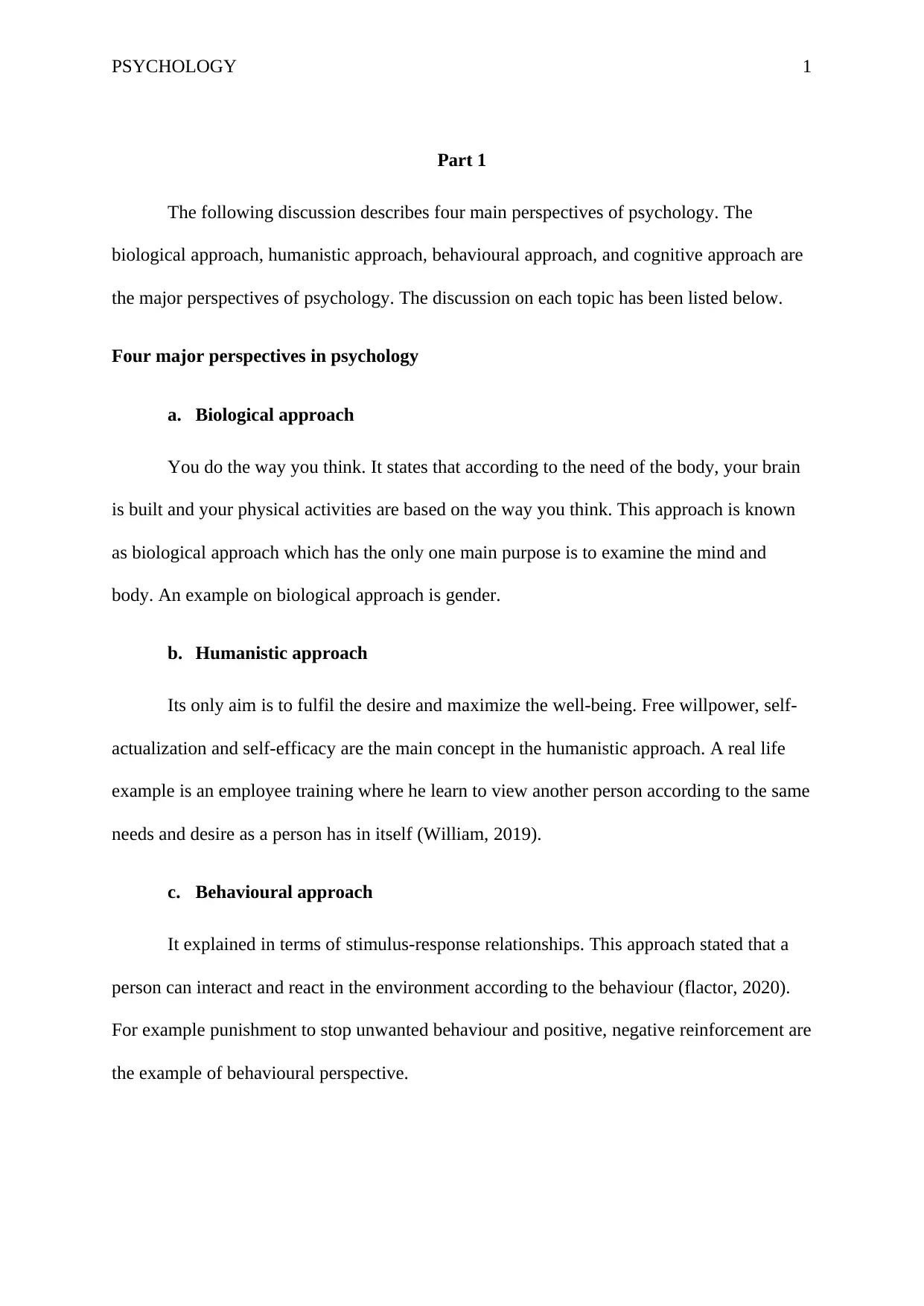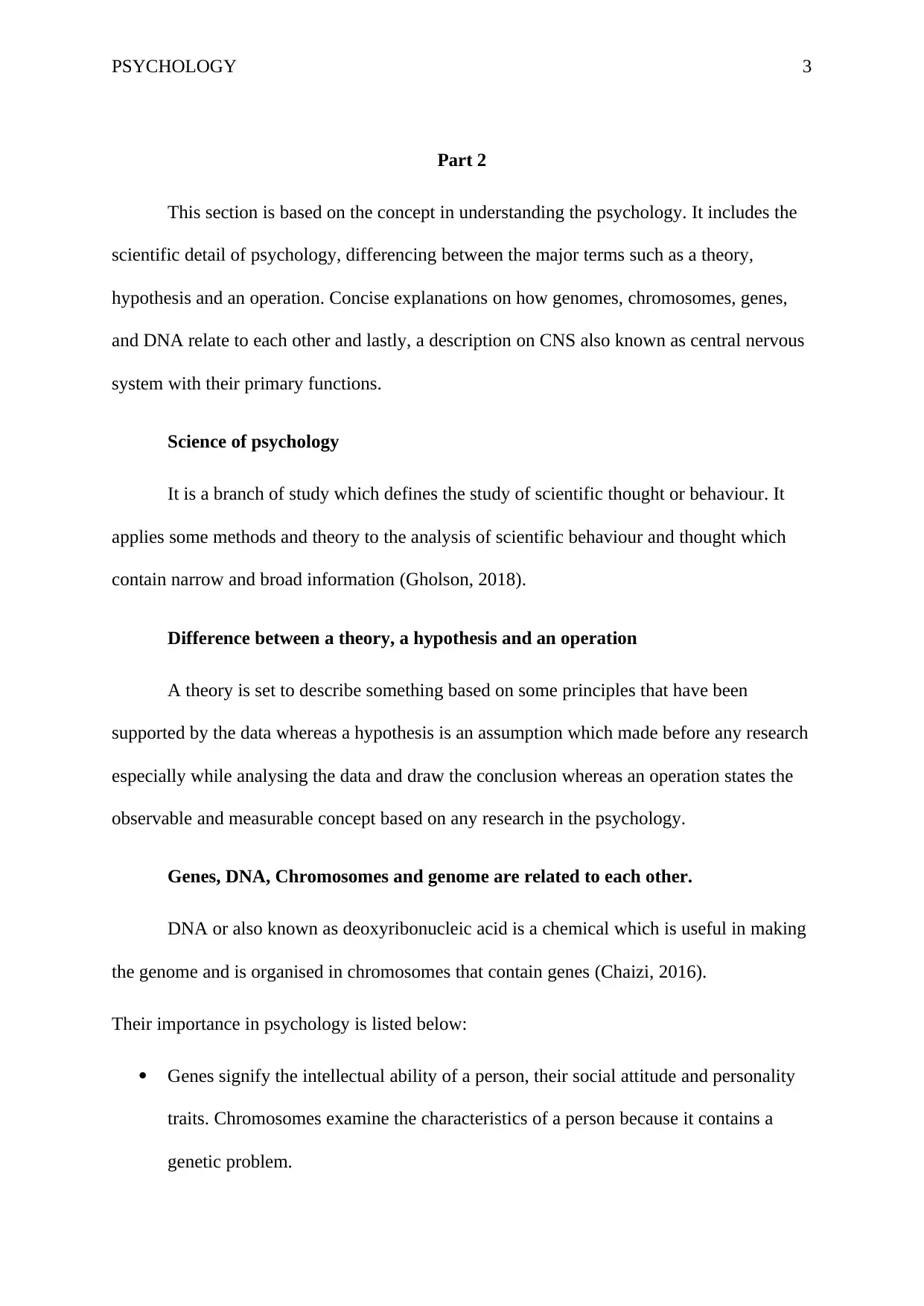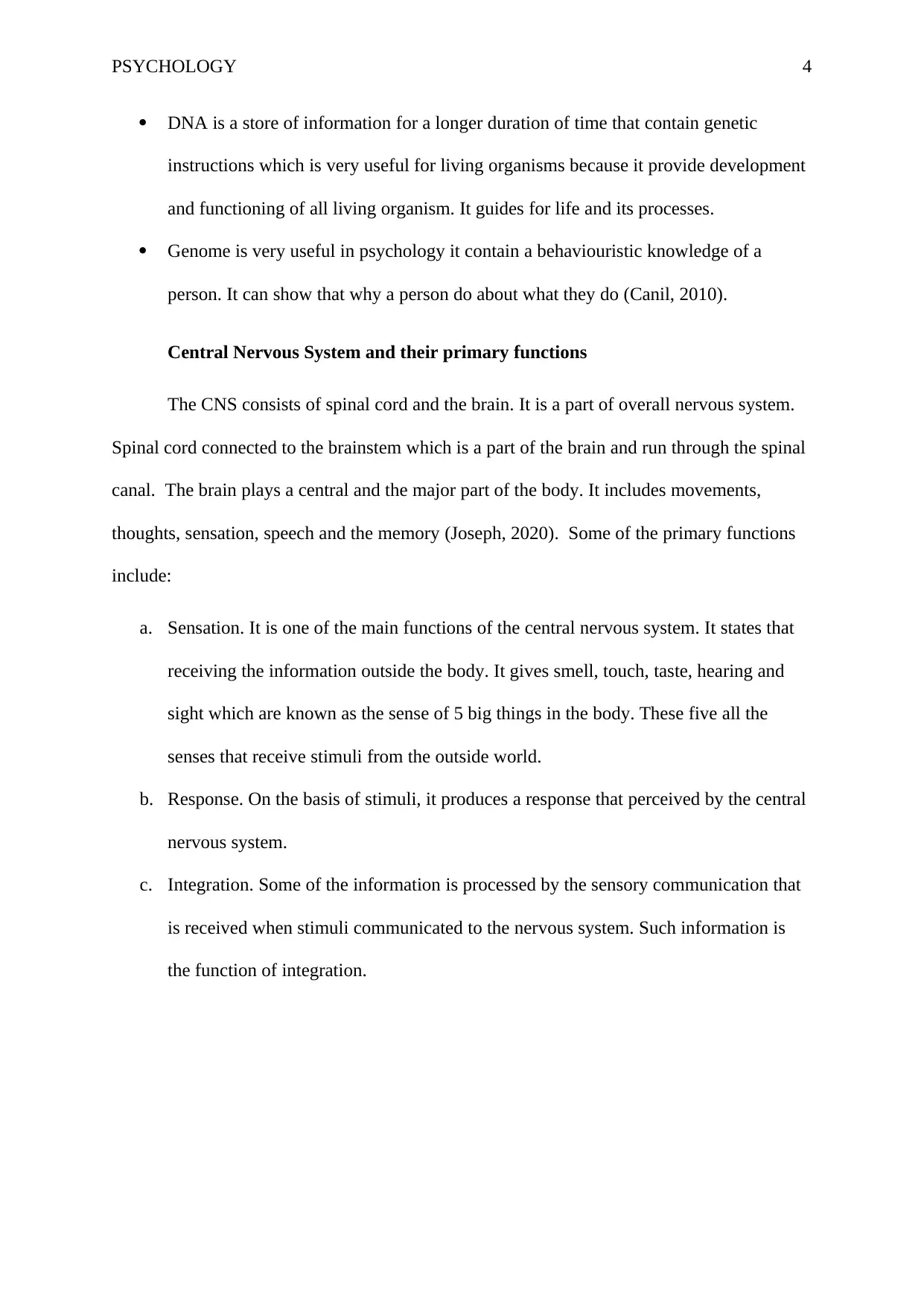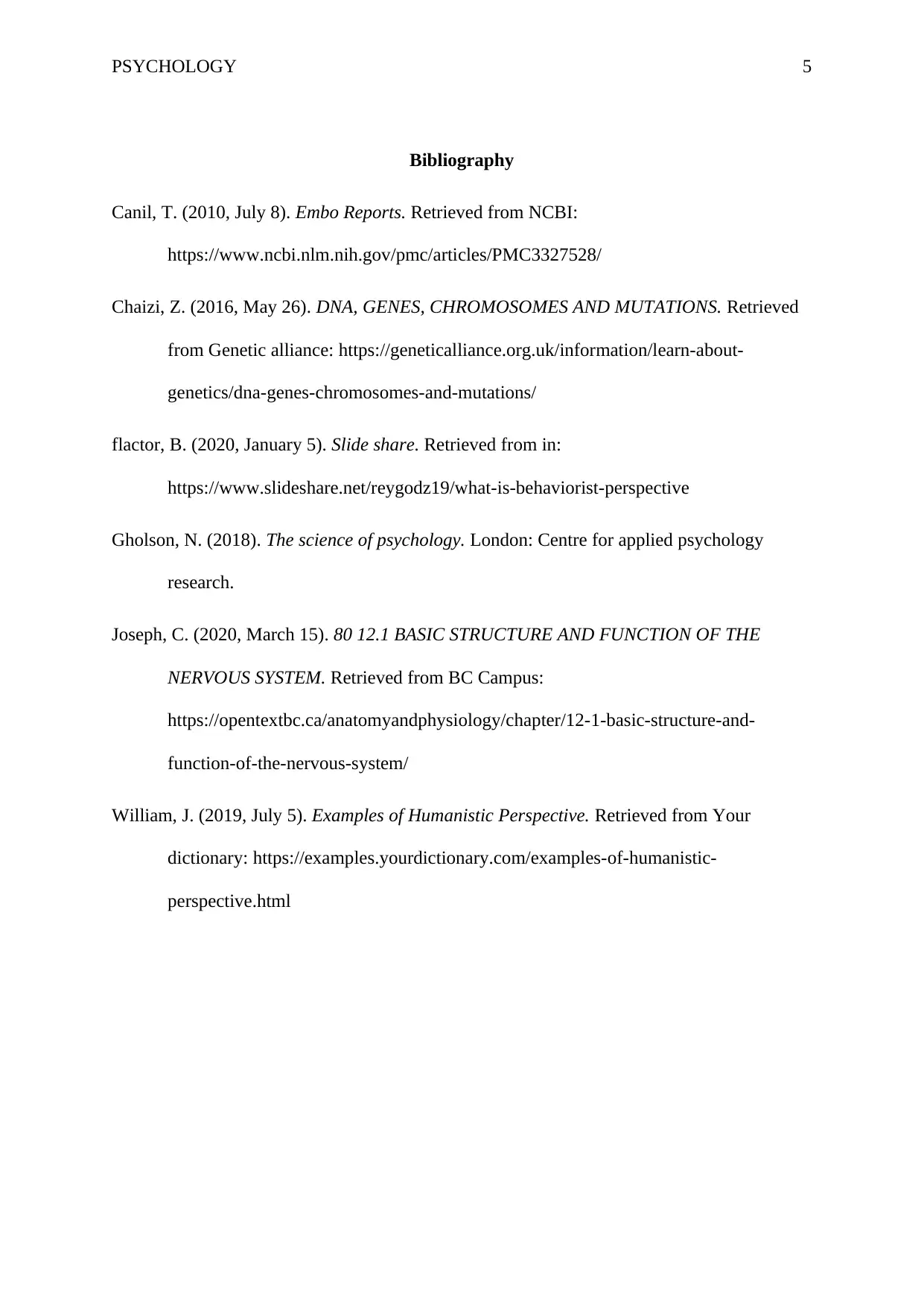Psychology 101 - Exploring Psychological Approaches and Concepts
VerifiedAdded on 2022/08/18
|6
|985
|18
Essay
AI Summary
This assignment provides a comprehensive overview of the four major perspectives in psychology: biological, humanistic, behavioral, and cognitive, including real-life examples for each. It further delves into the scientific aspects of psychology, differentiating between a theory, a hypothesis, and an operation. The document explains the relationship between genes, DNA, chromosomes, and the genome and their importance in understanding human behavior. Finally, it describes the central nervous system (CNS) and its primary functions, such as sensation, response, and integration. The assignment references key sources and provides a solid foundation for understanding core psychological concepts. This assignment is available on Desklib, a platform that provides students with resources for their studies.

Running Head: PSYCHOLOGY 0
Understanding psychology and its approaches
Understanding psychology and its approaches
Paraphrase This Document
Need a fresh take? Get an instant paraphrase of this document with our AI Paraphraser

PSYCHOLOGY 1
Part 1
The following discussion describes four main perspectives of psychology. The
biological approach, humanistic approach, behavioural approach, and cognitive approach are
the major perspectives of psychology. The discussion on each topic has been listed below.
Four major perspectives in psychology
a. Biological approach
You do the way you think. It states that according to the need of the body, your brain
is built and your physical activities are based on the way you think. This approach is known
as biological approach which has the only one main purpose is to examine the mind and
body. An example on biological approach is gender.
b. Humanistic approach
Its only aim is to fulfil the desire and maximize the well-being. Free willpower, self-
actualization and self-efficacy are the main concept in the humanistic approach. A real life
example is an employee training where he learn to view another person according to the same
needs and desire as a person has in itself (William, 2019).
c. Behavioural approach
It explained in terms of stimulus-response relationships. This approach stated that a
person can interact and react in the environment according to the behaviour (flactor, 2020).
For example punishment to stop unwanted behaviour and positive, negative reinforcement are
the example of behavioural perspective.
Part 1
The following discussion describes four main perspectives of psychology. The
biological approach, humanistic approach, behavioural approach, and cognitive approach are
the major perspectives of psychology. The discussion on each topic has been listed below.
Four major perspectives in psychology
a. Biological approach
You do the way you think. It states that according to the need of the body, your brain
is built and your physical activities are based on the way you think. This approach is known
as biological approach which has the only one main purpose is to examine the mind and
body. An example on biological approach is gender.
b. Humanistic approach
Its only aim is to fulfil the desire and maximize the well-being. Free willpower, self-
actualization and self-efficacy are the main concept in the humanistic approach. A real life
example is an employee training where he learn to view another person according to the same
needs and desire as a person has in itself (William, 2019).
c. Behavioural approach
It explained in terms of stimulus-response relationships. This approach stated that a
person can interact and react in the environment according to the behaviour (flactor, 2020).
For example punishment to stop unwanted behaviour and positive, negative reinforcement are
the example of behavioural perspective.

PSYCHOLOGY 2
d. Cognitive approach
This approach is highly based on expectations and emotions. The expectations on
something will affect how you feel and this approach is also based on emotional connection
with other person. An example based on this approach is assuming something and making
judgement based on information you received and keeping expectations or feeling emotional
is an example of this perspective of psychology.
d. Cognitive approach
This approach is highly based on expectations and emotions. The expectations on
something will affect how you feel and this approach is also based on emotional connection
with other person. An example based on this approach is assuming something and making
judgement based on information you received and keeping expectations or feeling emotional
is an example of this perspective of psychology.
⊘ This is a preview!⊘
Do you want full access?
Subscribe today to unlock all pages.

Trusted by 1+ million students worldwide

PSYCHOLOGY 3
Part 2
This section is based on the concept in understanding the psychology. It includes the
scientific detail of psychology, differencing between the major terms such as a theory,
hypothesis and an operation. Concise explanations on how genomes, chromosomes, genes,
and DNA relate to each other and lastly, a description on CNS also known as central nervous
system with their primary functions.
Science of psychology
It is a branch of study which defines the study of scientific thought or behaviour. It
applies some methods and theory to the analysis of scientific behaviour and thought which
contain narrow and broad information (Gholson, 2018).
Difference between a theory, a hypothesis and an operation
A theory is set to describe something based on some principles that have been
supported by the data whereas a hypothesis is an assumption which made before any research
especially while analysing the data and draw the conclusion whereas an operation states the
observable and measurable concept based on any research in the psychology.
Genes, DNA, Chromosomes and genome are related to each other.
DNA or also known as deoxyribonucleic acid is a chemical which is useful in making
the genome and is organised in chromosomes that contain genes (Chaizi, 2016).
Their importance in psychology is listed below:
Genes signify the intellectual ability of a person, their social attitude and personality
traits. Chromosomes examine the characteristics of a person because it contains a
genetic problem.
Part 2
This section is based on the concept in understanding the psychology. It includes the
scientific detail of psychology, differencing between the major terms such as a theory,
hypothesis and an operation. Concise explanations on how genomes, chromosomes, genes,
and DNA relate to each other and lastly, a description on CNS also known as central nervous
system with their primary functions.
Science of psychology
It is a branch of study which defines the study of scientific thought or behaviour. It
applies some methods and theory to the analysis of scientific behaviour and thought which
contain narrow and broad information (Gholson, 2018).
Difference between a theory, a hypothesis and an operation
A theory is set to describe something based on some principles that have been
supported by the data whereas a hypothesis is an assumption which made before any research
especially while analysing the data and draw the conclusion whereas an operation states the
observable and measurable concept based on any research in the psychology.
Genes, DNA, Chromosomes and genome are related to each other.
DNA or also known as deoxyribonucleic acid is a chemical which is useful in making
the genome and is organised in chromosomes that contain genes (Chaizi, 2016).
Their importance in psychology is listed below:
Genes signify the intellectual ability of a person, their social attitude and personality
traits. Chromosomes examine the characteristics of a person because it contains a
genetic problem.
Paraphrase This Document
Need a fresh take? Get an instant paraphrase of this document with our AI Paraphraser

PSYCHOLOGY 4
DNA is a store of information for a longer duration of time that contain genetic
instructions which is very useful for living organisms because it provide development
and functioning of all living organism. It guides for life and its processes.
Genome is very useful in psychology it contain a behaviouristic knowledge of a
person. It can show that why a person do about what they do (Canil, 2010).
Central Nervous System and their primary functions
The CNS consists of spinal cord and the brain. It is a part of overall nervous system.
Spinal cord connected to the brainstem which is a part of the brain and run through the spinal
canal. The brain plays a central and the major part of the body. It includes movements,
thoughts, sensation, speech and the memory (Joseph, 2020). Some of the primary functions
include:
a. Sensation. It is one of the main functions of the central nervous system. It states that
receiving the information outside the body. It gives smell, touch, taste, hearing and
sight which are known as the sense of 5 big things in the body. These five all the
senses that receive stimuli from the outside world.
b. Response. On the basis of stimuli, it produces a response that perceived by the central
nervous system.
c. Integration. Some of the information is processed by the sensory communication that
is received when stimuli communicated to the nervous system. Such information is
the function of integration.
DNA is a store of information for a longer duration of time that contain genetic
instructions which is very useful for living organisms because it provide development
and functioning of all living organism. It guides for life and its processes.
Genome is very useful in psychology it contain a behaviouristic knowledge of a
person. It can show that why a person do about what they do (Canil, 2010).
Central Nervous System and their primary functions
The CNS consists of spinal cord and the brain. It is a part of overall nervous system.
Spinal cord connected to the brainstem which is a part of the brain and run through the spinal
canal. The brain plays a central and the major part of the body. It includes movements,
thoughts, sensation, speech and the memory (Joseph, 2020). Some of the primary functions
include:
a. Sensation. It is one of the main functions of the central nervous system. It states that
receiving the information outside the body. It gives smell, touch, taste, hearing and
sight which are known as the sense of 5 big things in the body. These five all the
senses that receive stimuli from the outside world.
b. Response. On the basis of stimuli, it produces a response that perceived by the central
nervous system.
c. Integration. Some of the information is processed by the sensory communication that
is received when stimuli communicated to the nervous system. Such information is
the function of integration.

PSYCHOLOGY 5
Bibliography
Canil, T. (2010, July 8). Embo Reports. Retrieved from NCBI:
https://www.ncbi.nlm.nih.gov/pmc/articles/PMC3327528/
Chaizi, Z. (2016, May 26). DNA, GENES, CHROMOSOMES AND MUTATIONS. Retrieved
from Genetic alliance: https://geneticalliance.org.uk/information/learn-about-
genetics/dna-genes-chromosomes-and-mutations/
flactor, B. (2020, January 5). Slide share. Retrieved from in:
https://www.slideshare.net/reygodz19/what-is-behaviorist-perspective
Gholson, N. (2018). The science of psychology. London: Centre for applied psychology
research.
Joseph, C. (2020, March 15). 80 12.1 BASIC STRUCTURE AND FUNCTION OF THE
NERVOUS SYSTEM. Retrieved from BC Campus:
https://opentextbc.ca/anatomyandphysiology/chapter/12-1-basic-structure-and-
function-of-the-nervous-system/
William, J. (2019, July 5). Examples of Humanistic Perspective. Retrieved from Your
dictionary: https://examples.yourdictionary.com/examples-of-humanistic-
perspective.html
Bibliography
Canil, T. (2010, July 8). Embo Reports. Retrieved from NCBI:
https://www.ncbi.nlm.nih.gov/pmc/articles/PMC3327528/
Chaizi, Z. (2016, May 26). DNA, GENES, CHROMOSOMES AND MUTATIONS. Retrieved
from Genetic alliance: https://geneticalliance.org.uk/information/learn-about-
genetics/dna-genes-chromosomes-and-mutations/
flactor, B. (2020, January 5). Slide share. Retrieved from in:
https://www.slideshare.net/reygodz19/what-is-behaviorist-perspective
Gholson, N. (2018). The science of psychology. London: Centre for applied psychology
research.
Joseph, C. (2020, March 15). 80 12.1 BASIC STRUCTURE AND FUNCTION OF THE
NERVOUS SYSTEM. Retrieved from BC Campus:
https://opentextbc.ca/anatomyandphysiology/chapter/12-1-basic-structure-and-
function-of-the-nervous-system/
William, J. (2019, July 5). Examples of Humanistic Perspective. Retrieved from Your
dictionary: https://examples.yourdictionary.com/examples-of-humanistic-
perspective.html
⊘ This is a preview!⊘
Do you want full access?
Subscribe today to unlock all pages.

Trusted by 1+ million students worldwide
1 out of 6
Related Documents
Your All-in-One AI-Powered Toolkit for Academic Success.
+13062052269
info@desklib.com
Available 24*7 on WhatsApp / Email
![[object Object]](/_next/static/media/star-bottom.7253800d.svg)
Unlock your academic potential
Copyright © 2020–2025 A2Z Services. All Rights Reserved. Developed and managed by ZUCOL.




